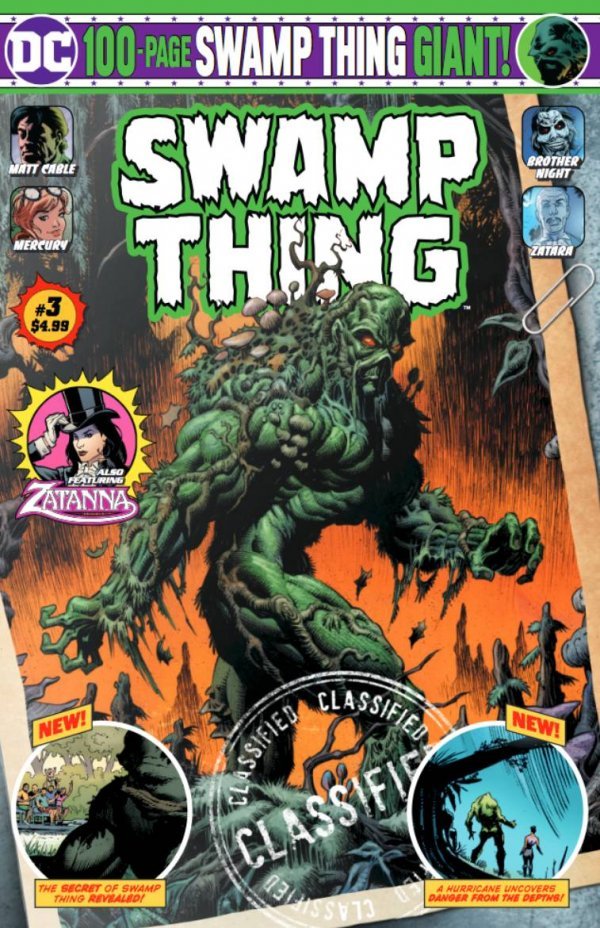Comic Book Review: Swamp Thing Giant #3 by various creators
Scientist Alec Holland and his wife Linda were working on a plant-based bio-restorative formula in the Louisiana swamps when criminals set a bomb to sabotage the research and he was burned to death. A combination of the formula and other forces working within the swamp caused Alec to rise again as the muck creature called Swamp Thing. Years later, it was revealed that Swamp Thing was in fact an entirely new creature, an avatar of the Green, who simply had Alec Holland’s memories and emotions.

The character was created in 1972 by Len Wein and Bernie Wrightson, after a one-shot horror story with a similar setup had proved successful. Swamp Thing was created about the same time as Marvel’s Man-Thing, which had a very similar origin, but both were inspired by a Golden Age character named the Heap, which was in turn a riff on an earlier pulp science fiction story. Swamp Thing was a decently popular character who sold okay and had his own series for twenty four issues at the end of which he was cured.
In 1982, DC Comics revived the series as there was now a Swamp Thing movie, and the last few issues of the previous version were quietly ignored. Sales dropped rapidly, and in 1984, Alan Moore was given a free hand as writer. He created the new version of Swamp Thing’s origins, amped up the weirdness level, and sales skyrocketed. So it is that his version of the character largely stuck, and it’s why Swamp Thing is the headliner in this “giant” comic book.
“Gods of the Abyss” written by Mark Russell with art by Marco Santucci, takes place in a rebooted continuity where Alec Holland is pursued by the Sunderland Corporation (the early baddies of the Moore years.) The Swamp Thing has become a known cryptid, and tourists are invading the swamp in efforts to see and interact with it. This pleases neither Swampy, who would rather be left alone, nor Sunderland, which doesn’t want any interference.
After Sunderland employee Robert (whose grandfather was a friend of Swamp Thing’s) leads an expedition to try to capture/kill Swampy, the Green elemental destroys the local corporate building to send the message not to push any further. Robert is sent out again, this time alone, to make a deal with Swamp Thing, anything to de-escalate the situation. But Swamp Thing finds him dead and mistakenly thinks that Sunderland is responsible.
Swampy retaliates by smashing CEO General Sunderland’s mansion, and the general declares all out war. Meanwhile, Swamp Thing stumbles across more corpses, and learns the shocking truth as to who the real killers are.
“The Courser” written by Phil Hester with art by Tom Mandrake, is a done in one story. Archaeologists race against an oncoming hurricane to locate an raise a sunken ship. Their sponsor, however, has sinister plans involving their lives and his own freedom. Will Swamp Thing’s intervention be enough to prevent the evil man’s triumph? Content note: slavery.
Then it’s time for three reprints!
“Fateful Reunion” written by Len Wein with art by Kelley Jones, uses the New 52 reboot version of Swamp Thing. In this version, we’re somewhat back to Alec Holland being the actual person trapped in the body of the Swamp Thing. His old friend Matt Cable has found an artifact that could possibly lift the curse of the Green from him. They visit the magician Zatanna to make the Hand of Fatima work, but there’s an utterly predictable twist.
“The Poison Truth, Part 3” written by Simon Oliver with art by Moritat, features John Constantine. Constantine was created during the Moore run, a Cockney urban magician whose most distinguishing trait is that everyone who interacts with him gets damaged. Especially anyone who befriends or loves him. Swamp Thing has asked Constantine for help finding Abigail Arcane, Swampy’s paramour and current avatar of the Rot. While Swamp Thing and guest psychic Mercury enter the Rot to search from that end, Constantine looks for clues in London.
Unfortunately, it turns out that London right now is being invaded by the Djinn, who may or may not be connected with Abby’s disappearance, and they would very much like to kill Constantine. Also, one of Constantine’s few remaining mostly intact friends, Chas, has managed to get gangsters angry at him and Constantine, which may or may not have anything to do with the two other plotlines.
“Night on Devil Mountain” written by Paul Dini with art by Stephane Roux, stars Zatanna herself. Zatanna was created by Gardner Fox and Murphy Anderson back in the Silver Age in an interesting storyline that hopped between different comic books back when that was a rare thing. Zatanna was looking for her father Zatara (a Golden Age character), a backwards-speaking magician who’d disappeared some years before. She’d appear in a given superhero’s title looking for clues, the hero would team up with her, but no luck until finally she teamed up with the entire Justice League. Some years and training with her recovered father later, she joined the League as their resident mage, and some years after that, Zatara was killed off during a Swamp Thing story.
In this tale, Zatanna (who is a stage magician in her “day job”) is battling the evil sorcerer Brother Night. She’s beaten his other attempts to kill her, so now Brother Night decides to lure her to his place of power, Devil Mountain, and unleash his most powerful slave to slay her. After all, how could she battle the ghost of Zatara, her own father?
This issue ends on a happier note, as a certain amount of justice is done.
The Len Wein story is a little too predictable for as many pages as it takes up, and the Zatanna story is the most satisfying. I really like Tom Mandrake’s art.
Recommended for fans of the characters.

